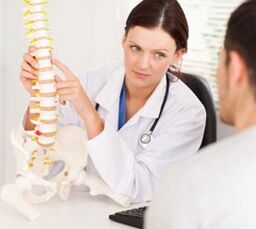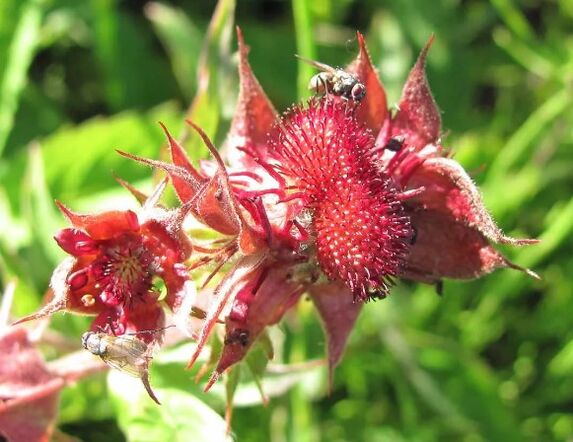Osteochondrosis-The disease of the spine, a characteristic characteristic of which is the degenerative dyeing of the intervertebral discs, and therefore the vertebral tissues themselves.
The main sign of osteocondrosis is neck or back pain. Other symptoms, muscle atrophy, compromised sensitivity, disorders in the work of internal organs are distinguished. Depending on the location of the pathological process, cervical, thoracic and lumbar osteochondrosis are distinguished. If this disease and its treatment do not pay the necessary attention, the process of damage to the spine will be irreversible.

In English literature, the term "osteochondrosis" indicates such a group of diseases of the musculoskeletal system, such as osteocondropathy.
The main factor, or the cause that leads to the development of the osteocondrosis, is an irregular distribution of the load on the spine, which occurs when wearing in a hand or a shoulder of weights (for example, bags, backpack), a long stay in a position sitting in the incorrect installation, night rest on an irregular mattress or a cushion. Further factors can also be a sedentary lifestyle, obesity, injuries and flat feet.
All the situations above over the years lead to frequent pain in the cervical column, chest or sacral.
According to statistics, osteochondosis occurs from 40 to 90% of the world population, mainly from the age of 30-35. In adverse conditions, this disease develops in adolescent people, which often contributes to the use of a discomfort backpack, in particular on one shoulder, discomfort and injury shoes.
The development of osteochondosis
The development of osteocondrosis occurs in 4 selected phases (grade):
Osteochondrosis of the 1st stadium.It is characterized by the beginning of the pathological process in the polypozom nucleus of the intervertebral disc: its dehydration (dehydration) occurs and subsequently the height of the disc decreases. At the same time, cracks begin to appear on the fibrous ring. At this stage, the patient usually does not hear changes. The discomfort can manifest itself with an unusual position for a person or active exercise.
Stadiums of osteochondrosis 2.With a decrease in the height of the discs, the distance between the nearby vertebrae also decreases and the vertebrates and the ligaments begin to lower slightly. This process leads to the ultravity of two nearby vertebrae, which can lead to their sliding and/or movement. It is formed spondilolistz. Due to the displaced vertebrae, the patient at a certain load feels a true discomfort and sometimes pain in the field of pathology.
Osteochondrosis 3 phases.It is characterized by the formation of prolapesse and record protrusions, sometimes subluxation and arthrosis occur in the intervertebral joints. The patient may feel rigid in some movements, feeling tingling in the limbs, sometimes appears to be numb. At the 3rd degree of osteochondrosis, the pain in the rear, the neck and the area of the coccyx, depending on the location of the disease, are already present.

Osteochondrosis 4 stadiums.The body is trying to correct the excessive mobility of the vertebrae and normalize the functioning of the spine. In the place of connection of the vertebrae with the pathology, bone neoplasms grow on each of them - osteophytes which, when forming in a useless place, can cause microtrauma to a nervous spine and sometimes a nearby vertebra. In records and joints, fibrous ankylosis processes can begin. The engine segment is invaded and becomes as if it were merit. At the same time, the main signs of osteochondrosis are minimized and sometimes in general, practically not evident.
Symptoms of osteochondrosis
The main symptoms of osteochdrosis are discomfort and pain in the back or neck. The strength of pain and other related signs of this disease depend on the degree of osteochondrosis.
Of course, due to the pathology of the intervertebral discs, their hernias, the outcrops on the vertebrae (osteophytes), there is a large number of disorders, such as circulatory disorders, pinching of nerves, irritation and violations in the normal operation of the spinal cordon, edema and even fibrosis of the vertebra that surrounds the vertebrae. All these disorders can cause a large clinical picture of the disease and be expressed by an abundant quantity of different symptoms, therefore, without a complete diagnosis of osteochondrosis, it is very difficult to make the correct diagnosis and prescribe adequate treatment.
However, we will consider the main symptoms of osteocondrosis:
- pain in the rear, cervical region, low back, shoulders and even ribs;
- discomfort, stiffness of the back with some movements, lifting something;
- numbness of the limbs (arms and/or legs);
- the feeling of pain in the arms and legs, the chills;
- Muscle cramps;
- Disorders in the work of the genitals;
- headache, dizziness;
- Heart pain;
- compromised sensitivity;
- muscle hypotension;
- Increase in fatigue, sometimes the eye.
Furthermore, depending on the area of the spine in which osteochondrosis has struck, the following symptoms are distinguished:
Osteochondrosis of the cervical column.The pain prevails in the hands and shoulders, headache, dizziness, "flies" or spots in front of the eyes, noise in the head. These signs can also indicate the presence of the vertebral artery syndrome, which can also complicate the work of the heart muscle and the blood vessels of the myocardium, if there are other diseases.
Osteochondrosis of the thoracic spine. Pain in the chest prevail, areas of the heart and discomfort in breathing.
Osteochondrosis of the Lumbosacral column.Pain prevails in the lower back of the back, giving the legs or pelvic organs. Violation of sexual function.

Complications of the osteochondrosis
If osteochondrosis is not treated and put around, this can lead to the development of the following diseases and pathologies:
- a hernia of the intervertebral disc (hernia of the spine);
- protrusion;
- Cifosis;
- roots;
- deposit in the space between the vertebrae of the salts;
- spinal cord race;
- losing the weight of the limbs and their atrophy;
- Paralysis of the legs.
The causes of osteochondosis
- mechanical back trauma (spine);
- Physical supervision of the body, hard work;
- nervous exhaustion, stress;
- Violation of the metabolism, poisoning;
- frequent stay in places with increased vibrations;
- hereditary predisposition;
- sedentary lifestyle, sedentary work;
- violation of posture at an early age;
- Excess weight, obesity;
- flat feet;
- Wear uncomfortable shoes (narrow, heels);
- Night holiday on an uncomfortable bed: a mattress, a pillow;
- frequent dehydration;
- lower nutrition, hypovitaminosis;
- smoke;
- pregnancy.
Classification of the osteocondrosis
The classification of osteochondrosis is very diversified, because the disease itself has not been completely studied.
We highlight the most popular ways to separate this disease.
Osteocondrosis stands out. . .
For localization:
- The Cervical Department ©
- Thoracic region (TH or D)
- Lumbar (l)
- The Sacral Department (s)
Diagnosis of osteochondrosis
The diagnosis of osteochondrosis includes the following exam methods:
- anamnesis;
- Exam X -Ray (X -Ray);
- myelography;
- Neurological examination.
They can also appoint:
- computerized tomography (CT);
- nuclear magnetic resonance imaging (Jamr);
- Magnetic resonance imaging tomography).
Treatment of osteocondrosis
The treatment of osteocondrosis implies the use of a series of measures that must be performed for a fairly long period of time (for 1-3 months + about 1 year to rehabilitation), to which many patients react in a very ambiguous way. Therefore, it should be noted that, indirectly, the recommendations of the attending physician, the prediction for the recovery of the patient is minimal.

A further problem in the treatment of osteochondrosis often becomes cars -medial. The fact is that, as already written in the article, with this disease, the clinical picture is quite ambiguous and wide. The patient without diagnostics begins to select medicines against what hurts and, eliminating pain, therefore deals with his daily life, while the disease continues to progress.
The treatment of osteocondrosis is carried out with two main methods: conservative and surgical treatment. In addition, there are general recommendations in the treatment of osteocondrosis, such as a diet, rehabilitation.
Conservative treatment of osteochondosis
The conservative treatment of the osteocondrosis has the purpose of stopping pain syndrome, normalization of the spine and its components, as well as the prevention of further dystrophic changes in the axis of a person.
The conservative treatment of osteochondrosis includes:
Drug therapy.It is used to relieve the pain and inflammation of the components of the spine of tissues, as well as the normalization of metabolic processes.
To stop the processes of pain and inflammation, various therapeutic blocks are also used. In addition, they contribute to a decrease in muscle-syndic syndrome. Among the therapeutic block there are: blocking of trigger points, as well as intra-bone, paravertebral and epidural block.
Physiotherapy.It is used to relieve pain, improving the effectiveness of drug therapy and in the rehabilitation period. The treatment is carried out using ultrasound, laser, magnetic fields, low frequency currents, etc.
Medical physical education (exercise therapy), Kinesitherapy.Specifically selected dose exercises aimed at correcting the muscle corset, its strengthening, the correction of posture, the normalization of muscle tissue and their flexibility, decompression of the nerve roots, preventing possible complications of the disease. Everything above is achieved due to the normalization of the metabolism and the nutrition of intervertebral discs, blood circulation, restores the distance of discs and vertebrae, distribution of the load on the entire musculoskeletal system.
Massage.It is used to improve blood circulation, relieve the rigidity and tension of muscle tissue, improve the general state of health.
Hydromass.It contributes to the normalization of blood circulation, to the metabolism, to the increase in the tone of muscle tone and the normalization of the nervous system. It implies body massage with the help of a water flow with a certain targeted pressure on it. True, the hydromass has recently been prevalent using air bubbles supplied to the body in specially equipped bathrooms or swimming pools.
Manual therapy.It is used on the basis of a selected program individually, which clearly affects the bone muscle system. It helps to improve blood circulation and lymph-cyclo, metabolism, the mobility of the musculoskeletal system, strengthen the immune system and prevent possible complications.
Extension (traction) of the spine.It is used using special equipment, to increase the intervertebral space, the correction of the structure of the spine, which usually leads to minimize or completely relieve pain.
The integrated use of the above treatment for osteochondrosis has a good effect.
Diet for osteochondrosis
With osteochondrosis, it is necessary to eat 6 times a day, in small portions, drinking at least 1, 5 liters of water per day.
What can be eaten with osteochondrosis:Lattiero -Caseari products, variety with low meat fat (chicken, beef), gelatin, flooded fish, jelly meat, fresh vegetables (tomatoes, cucumbers, onions, carrots, beets, pepper, cabbage, celery, broccoli), fruits, avocado, walnuts, sun flow seeds, spinach, mushrooms, cereals.
What must be reduced to a minimum in food for osteochondrosis:Grapes, legumes (peas, beans, etc. ), flour products, spicy condiments, sugar, salty foods, meat broths and smoked meats.
It is better to cook food, because with this method of preparation, the products maintain the maximum amount of vitamins and trace elements.

Try to season salads with olive oil.
Surgical treatment of osteochondrosis
The surgical treatment of osteochondrosis is used if the conservative method is ineffective. Prescribed by the attending physician. It can also be used for serious injuries of the spine and its components.
Treatment of osteocondrosis with popular remedies
Popular remedies against osteochondosis
Dough.Prepare a little pasta from rye flour, 300 grams and let it lie down at room temperature for a couple of days. Drink a glass of milk and rub the place where the back hurts with terrible. After enveloping the dough in the gauze and fix it to the sore point, tie a cellophane at the top and then a scarf or a towel. After some time, you can feel burning and tingling in that area, but tolerate as much as you can. Perform the procedure on alternate days. Use each lot of pasta no more than 3 times.
Saber.Make a tincture from Sabre fish. The place where the back hurts, with the tincture prepared with the prepared dye and tie it with a handkerchief. In addition, you can take a tincture from Sabre fish a few drops before bedtime.
Ointment from osteochondrosis.Add 1 tablespoon to the container. A spoonful of flour, 1 egg, 100 g of butter and 1 tablespoon. A spoonful of vinegar, mix everything carefully and put in a dark place for 2 days, to insist. After eliminating the foam resulting from the mixture. Once again, mix the mixture well and rub the exagnno of ointment resulting in a sore point.
Radish.Mix 300 ml of radish juice, 200 g of honey and 100 ml of vodka. Rub the back with the resulting mixture. This popular remedy also helps with radicalitis and rheumatism.




































